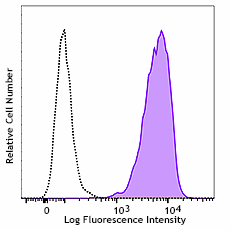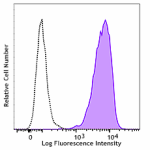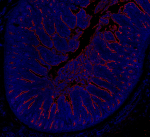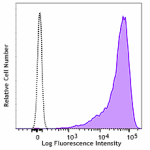- Clone
- NCRC37 (See other available formats)
- Regulatory Status
- RUO
- Other Names
- SC104
- Isotype
- Mouse IgG1, κ
- Ave. Rating
- Submit a Review
- Product Citations
- publications

-

Human colorectal tumor cell line COLO205 was stained with purified CD174 (clone NCRC37, filled histogram) or purified mouse IgG1, κ isotype control (open histogram) followed by Goat anti-mouse IgG FITC (clone Poly4053). -

Human paraffin-embedded intestine tissue slices were prepared with a standard protocol of deparaffinization and rehydration. Antigen retrieval was done with Citrate Buffered 1X (1.0M, pH 7.4) at 95°C for 40 minutes. Tissue was washed with PBS/0.05% Tween 20 twice for five minutes and blocked with 5% FBS and 0.2% gelatin for 30 minutes. Then, the tissue was stained with 10 µg/mL of purified anti-human CD174 (clone NCRC37) overnight at 4°C. On the next day, tissue was incubated with Alexa Fluro® 594 goat anti-mouse IgG (Clone Poly4054) antibody (red) for an hout at room temperature. Nuclei were counterstained with DAPI (blue). The image was scanned with a 10X objective and stitched with MetaMorph® software.
| Cat # | Size | Price | Quantity Check Availability | Save | ||
|---|---|---|---|---|---|---|
| 392602 | 100 µg | 244€ | ||||
CD174 is also known as Lewis Y, Fucosyltransferase 3, Galactoside 3(4)-L-fucosyltransferase which is encoded by FUT3 gene. FUT3 protein has 361a.a., around 39.7 kD and is highly expressed on duodenum and small intestine. The Lewis histo-blood group system comprises a set of fucosylated glycosphingolipids that are synthesized by exocrine epithelial cells and circulate in body fluids. The glycosphingolipids function in embryogenesis, tissue differentiation, tumor metastasis, inflammation, and bacterial adhesion. They are secondarily absorbed to red blood cells giving rise to their Lewis phenotype. Mutations in this gene are responsible for the majority of Lewis antigen-negative phenotypes.
Product DetailsProduct Details
- Verified Reactivity
- Human
- Antibody Type
- Monoclonal
- Host Species
- Mouse
- Immunogen
- Tissue cultured colorectal tumor cell line (C170, C146, COLO205, and JW)
- Formulation
- Phosphate-buffered solution, pH 7.2, containing 0.09% sodium azide.
- Preparation
- The antibody was purified by affinity chromatography.
- Concentration
- 0.5 mg/ml
- Storage & Handling
- The antibody solution should be stored undiluted between 2°C and 8°C.
- Application
-
FC - Quality tested
IHC-P - Verified - Recommended Usage
-
Each lot of this antibody is quality control tested by immunofluorescent staining with flow cytometric analysis. For flow cytometric staining, the suggested use of this reagent is ≤ 0.5 µg per million cells in 100 µl volume. For immunohistochemical staining of formalin-fixed paraffin-embedded tissue sections, a concentration of 10.0 µg/ml is suggested. It is recommended that the reagent be titrated for optimal performance for each application.
-
Application References
(PubMed link indicates BioLegend citation) -
- Durrant, LG. et al. 2006. Cancer Res. 66:5901-9
- RRID
-
AB_2728417 (BioLegend Cat. No. 392602)
Antigen Details
- Distribution
-
Highly expressed on glandular cells of duodenum and small intestine.
- Function
- May catalyze alpha-1,3 and alpha-1,4 glycosidic linkages involved in the expression of Vim-2, Lewis A, Lewis B, sialyl Lewis X and Lewis X/SSEA-1 antigens. May be involved in blood group Lewis determination; Lewis-positive (Le(+)) individuals have an active enzyme while Lewis-negative (Le(-)) individuals have an inactive enzyme.
- Biology Area
- Cancer Biomarkers, Cell Biology, Immunology
- Molecular Family
- CD Molecules
- Antigen References
-
- Durrant, LG. et al. 2006. Cancer Res. 66:5901-9
- Gene ID
- 2525 View all products for this Gene ID
- UniProt
- View information about CD174 on UniProt.org
Related Pages & Pathways
Pages
Related FAQs
Other Formats
View All CD174 Reagents Request Custom Conjugation| Description | Clone | Applications |
|---|---|---|
| Purified anti-human CD174 | NCRC37 | FC,IHC-P |
| Alexa Fluor® 594 anti-human CD174 | NCRC37 | IHC-P |
| Alexa Fluor® 647 anti-human CD174 | NCRC37 | IHC-P,FC |
Compare Data Across All Formats
This data display is provided for general comparisons between formats.
Your actual data may vary due to variations in samples, target cells, instruments and their settings, staining conditions, and other factors.
If you need assistance with selecting the best format contact our expert technical support team.
-
Purified anti-human CD174

Human colorectal tumor cell line COLO205 was stained with pu... 
Human paraffin-embedded intestine tissue slices were prepare... -
Alexa Fluor® 594 anti-human CD174

Human paraffin-embedded intestine tissue slices were prepare... -
Alexa Fluor® 647 anti-human CD174

Human paraffin-embedded intestine tissue slices were prepare... 
Human COLO205 cell line was stained with CD174 (clone NCRC37...
 Login / Register
Login / Register 








Follow Us